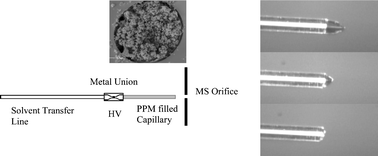Lectin affinity chromatography using porous polymer monolith assisted nanoelectrospray MS/MS
Abstract
An affinity porous polymer monolith is utilized as a nanoelectrospray emitter as well as an online affinity capture column for the preconcentration of glycans. Porous polymer monolith (PPM) assisted electrospray provides a facile methodology for coupling microfluidics to mass spectrometry that is sheathless and with zero dead volume. Affinity PPM was photopolymerized using glycidyl methacrylate/ethylene dimethacrylate utilizing different porogenic solvents based on aliphatic alcohols to provide PPMs with a variety of pore sizes. The use of longer alkyl chain alcohols decreased the pore size of the formed PPM as indicated by the higher flow back pressure generated. The effect of the pore size on the stability of the electrospray was tested showing higher stability of the TIC with lower pore size. A lectin, namely Concanavaline A, was immobilized on glycidyl methacrylate/ethylene dimethacrylate using the Schiff base method to provide an affinity monolith for high mannose glycans. The amount of the lectin immobilized was studied as a function of the porogenic solvent used in the polymerization. The glycopeptides of the glycoprotein Ribonuclease B was preconcentrated on the affinity PPM sprayer and detected by tandem MS.


 Please wait while we load your content...
Please wait while we load your content...